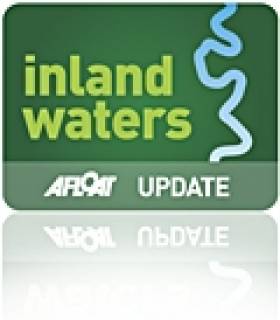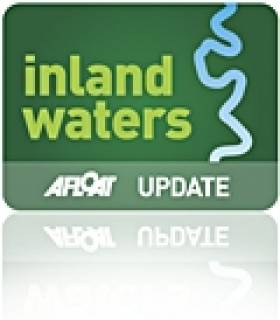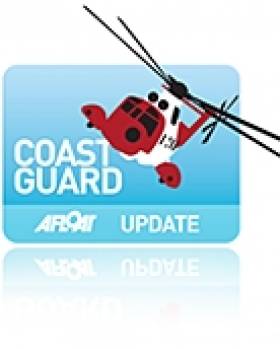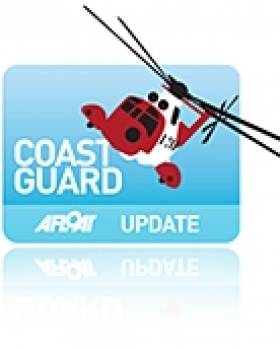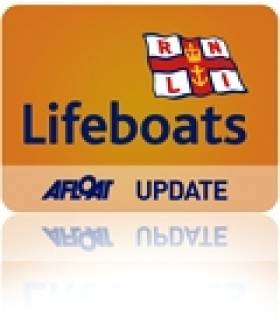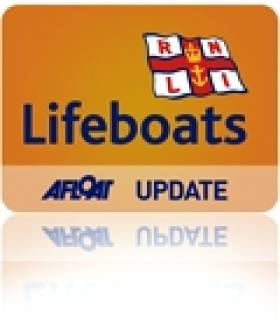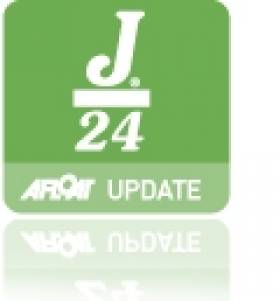Displaying items by tag: Lough Erne
Lough Erne Resort Sale to US 'Market Wizard' Confirmed
#InlandWaters - The Belfast Telegraph has confirmed the purchase of the Lough Erne Resort golf course by American billionaire businessman Tony Saliba.
As perviously reported on Afloat.ie, speculation was rife that the Chicago-based 'market wizard' was interested in snapping up the Co Fermanagh hotel and championship golf course, priced at a bargain £10 million after going into administration in 2011.
Now administrators with KPMG have confirmed that the five-star resort – with its Nick Faldo course that will host the 2017 Irish Open – has been sold to a private hospitality company led by an investment firm connected with the Saliba family.
The Belfast Telegraph has more on the story HERE.
Royal St.George Yacht Wins J24 National Title on Lough Erne
#j24 – Flor O'Driscoll's Hard on Port from the Royal St.George Yacht Club in Dun Laoghaire has taken the J24 national title for 2014 after three days of racing at Lough Erne Yacht Club in Co Fermanagh.
In the final day of racing at the Northern Ireland club, Hard on Port took line honours in the penultimate race of the day to set up the Royal St George Yacht Club entry for the title.
Stefan Hyde's RCYC entry, Hamilton Bear, pressed hard on the final day but was unable to mount a challenge strong enough to grasp the title away from the vastly experienced Munster man at the helm of Hard on Port.
Lighter winds were an ease to the competitors after the two previous days of gruelling conditions and with the sun shining down on Lough Erne, the trip up north paid off for the visiting boats.
Line honours for the last race of the day went to U25 crew on Kilcullen from Howth Yacht Club as local boat Jamais Encore pressed for a runner up spot.
Results:
Overall - Hard on Port Flor O'Driscoll RstGYC
Runner up - Hamilton Bear Stefan Hyde RCYC
3rd - Kilcullen Gordon Stirling HYC
4th - Jamais Encore JP McCaldin LEYC
5th - Crazy Horse Tim Corcoran Sligo
Billionaire Buys Up Lough Erne Golf Resort Say Reports
#InlandWaters - Donald Trump isn't the only American billionaire eyeing up Ireland's premier waterside golf courses, as the Belfast Telegraph reports Tony Saliba has purchased the championship-calibre Lough Erne Resort.
Despite going into administration just four years after its opening in 2008, the five-star hotel and its accompanying Faldo Championship Golf Course will be the location of the Irish Open in 2017, after its successful hosting last year's G8 summit.
And the Co Fermanagh resort's £10m asking price was surely attractive for Chicago-based Saliba, dubbed one of America's 'market wizards' in the 1980s and reportedly an avid golf fan.
The Belfast Telegraph has more on the story HERE.
New Buoy Moorings Proposed for Upper and Lower Lough Erne
#buoy moorings – Waterways Ireland proposes to roll-out a new style of mooring arrangement on Upper and Lower Lough Erne to create an opportunity for boaters to use and experience the waterway differently.
Waterways Ireland has submitted a request for planning permission to allow the creation of 18 buoy moorings across Upper and Lower Lough Erne.
A buoy mooring is a mooring buoy that is permanently attached by chain to an anchor on the lake bed at which a boat may tie up as an alternative to mooring at a jetty or deploying an anchor.
Waterways Ireland is installing this type of public mooring to offer boaters an alternative to mooring at a jetty. The locations have been chosen to provide safe, sheltered moorings in quiet locations. As only one boat can moor at a time, the buoy mooring offers a boater a more natural experience which some boaters are seeking.
In choosing the proposed locations Waterways Ireland has sought comment from user groups, the Environment Agency, Inland Fisheries and the RSPB. It is Waterways Irelands intention to provide safe moorings at locations that that will interest boaters but that will not result in a negative impact or disturbance to bird, fish or mammal species or their habitat.
These locations are not intended to give the boater egress to the land, but to provide a safe mooring opportunity away from other waterways users and offering a more intimate connection to nature.
In selecting the locations for these moorings Waterways Ireland has paid particular attention to the provision of safe navigation and a safe mooring in a range of water depths and wind directions and the avoidance of overhead electric wires (for craft under sail). Waterways Ireland has also taken into account the weight of craft in designing the mooring anchors and intends to cater for the heaviest cruisers presently on the navigation.
If planning permission is secured Waterways Ireland intends to proceed with laying the approved moorings and a number of these will be available for use in 2015.
Maps and information showing the proposed locations can be found on www.waterwaysireland.org
#coastguard – A search is ongoing for a man missing in Lough Erne last night after a boat with six people onboard overturned.
Belfast Maritime Rescue Coordination Centre received a 999 call at 6.15pm from a member of the public, close to Portora Boat Club, Enniskillen. The caller reported that a rowing boat had capsized off the boat club.
Two of the vessels for hire in the Lough had rescued five people but one is still missing. He is not believed to have been wearing a lifejacket.
Enniskillen Coastguard Team were sent to the scene to search the shoreline whilst RNLI lifeboats based in Enniskillen and Carrybridge were sent to search the water. The Irish Coast Guard helicopter based at Sligo has also joined the search along with a PSNI boat.
The five people recovered from the water where treated by the Northern Ireland Ambulance Service.
Gary Young Watch Manager said:
"An extensive search is continuing at this time and weather conditions are favourable in the area."
Lough Erne Get The Nod For Irish Open In 2017
#LoughErne - The Faldo Championship Course on the shores of Lough Erne in Fermanagh will host golf's prestigious Irish Open in 2017, as the News Letter reports.
The news comes as part of a double announcement for Northern Ireland, which will also host next year's event at Royal County Down at Newcastle on the east coast.
Coming not long after Royal Portrush's hosting of the tournament in 2012 - Northern Ireland's first after more than 50 years - the move is indicative of the quality of the North's many championship-calibre courses and golf links.
And here's hoping the North's golfers - including Royal County Down local boy Rory McIlroy - will get to show their stuff on their greens and fairways when the time comes!
Light Aircraft Ditches in Lough Erne
#coastguard – At 4.30pm tonight the Belfast Maritime Rescue Coordination Centre was advised by Shannon Air Traffic Control that a light aircraft with two people on board was about to ditch in the Loch Erne area due to low oil pressure.
Belfast Coastguard immediately requested helicopter assistance. The Irish Coastguard Rescue helicopter from Shannon and the Police helicopter proceeded to the scene along with the RNLI lifeboat from Carrybridge. The Erne Coastguard Rescue Team was also tasked to the shore side. Belfast Coastguard contacted all other emergency services, Fire, Police and Ambulance.
Incredibly the pilot was able to land the craft on the Loch very close to shore. The pilot and passenger were then able to swim the small distance ashore. The two casualties were checked over by waiting paramedics and then taken back to their accommodation by the Erne Coastguard Rescue Team.
Jude McNeice, Belfast Coastguard Watch Manager said,
The actions of this highly skilled pilot undoubtedly saved the lives of himself and his passenger. This potentially serious incident could've ended very differently; they are two very lucky men
#RNLI - Enniskillen RNLI will host the revived Castle Island charity swim and family fun morning in Enniskillen, Co Fermanagh on Sunday 11 August.
The swim traditionally took place each year with the support of the Blake family.
And Enniskillen RNLI have hailed as a "great honour" the opportunity for its local volunteer crew to revive the swim in association with sponsors Blakes the Hollow, Western Cars and The Print Factory.
The 750m swim on Lough Erne is open to swimmers of all ages either individually or in small groups such as youth clubs, sports clubs or simply groups of friends.
Enniskillen RNLI says the emphasis for this swim is for everyone to have fun and for that reason, if required, novice swimmers may complete the swim in a well-fitted lifejacket or buoyancy aid but must be confident that they can complete the distance.
Lifeboat crew not swimming themselves will also be present on the day to provide safety cover for the event.
Registration for the swim will take place at 12 noon on the day, followed by a short safety briefing. Sponsorship forms are available by email or can be collected at The Wig & Crown, Blakes the Hollow and Western Cars. For further information contact Adrian at 07974 730456.
In other news, RTÉ Radio 1’s The Business will broadcast live from Bundoran RNLI lifeboat station this Saturday morning 3 August.
The focus of the show will be on the business of Bundoran being a seaside resort - a reputation the Donegal town has enjoyed for more than two centuries.
Speaking ahead of his visit, programme host George Lee said: "I'm really looking forward to broadcasting from Bundoran, particularly on a bank holiday weekend. I'm hoping to experience lots of surfing, slots machines and ice-creams.
"On the show we'll be looking back at the heyday of the dancehalls, we'll be joined by Bundoran regular Ramona Nicholas from Dragon's Den, we'll be speaking to two men making money from oil exploration and lots, lots more."
The Business is broadcast Saturday morning at 10am on RTÉ Radio 1.
#RNLI - Enniskillen RNLI today (10 June) brought four people to safety in two separate incidents on Lough Erne in Co Fermanagh.
In the first call-out of the day, the volunteer lifeboat crew retrieved a man and women from their stranded cruiser which had developed engine problems and run aground on Lower Lough Erne.
The inshore lifeboat Joseph and Mary Hiley and the Rescue Water Craft (RWC) were launched just before 10am at the request of Belfast Coastguard and made the 25-minute, six-mile journey to the casualty's last known position at Crunnish Island. The wind was coming from the south east, force five with good visibility.
On arrival at the scene, the crew noted the casualties had deployed their anchor and there were strong waves hitting the starboard side of the vessel.
The RWC crew member was transferred to the casualty vessel to reassure the crew and to check for any leakage. Another crew member from the lifeboat was transferred to assist with the tow and to lift the anchor.
The lifeboat established a tow and the vessel was refloated and brought to safety at Tudor Farm jetty, close to the initial location.
Less than three hours later, the inshore lifeboat Jason Logg was launched by request of Belfast Coastguard to rescue two people on a broken-down personal water craft on Upper Lough Erne.
The crew proceeded to the casualty's last known whereabouts at the mouth of Tamlagh Bay, four miles downstream from the station towards Enniskillen.
On arrival, the crew found the troubled vessel in the reeds with two people sitting on it. The crew transferred both passengers onto the lifeboat before setting up a tow and bringing the water craft back to Bellanaleck Marina.
Elsewhere in Northern Ireland, Portaferry RNLI brought three men and a teenage boy to safety yesterday afternoon after their yacht got into difficulty off Portaferry in Co Down.
The volunteer lifeboat crew was alerted just after noon following a mayday call that there was a demasted yacht in trouble on Strangford Lough.
The lifeboat was launched minutes later and was alongside the stricken vessel, a 37ft yacht located in the narrows of Strangford Lough, at 12.10pm. Weather at the time was good with clear visibility and a flat calm sea.
One of the four casualties, who had been thrown from the vessel, had been recovered by a fellow crew member and all four were on board the yacht when the lifeboat crew arrived on scene.
Alongside, there was difficulty recovering the vessel so the mast and sail were cut away. Once cut, the lifeboat proceeded to tow the yacht with it crew on board safely back to Strangford where it was tied to a mooring.
Two of the crew were conveyed to hospital while the other two were made comfortable on the shore.
Portaferry RNLI was requested to launch for a second time later this afternoon following a report that a swimmer had gone missing in Newtownards. The lifeboat having launched was subsequently stood down after the missing person was found safe and well.
Clean Sweep for Local J24 Keelboat Ace on Lough Erne
Local J24 ace JP McCaldin, sailing Jamais Encore had a clean sweep on the first day of the J24 Northerns in Lough Erne and the no wind conditions on Sunday meant no more races were sailed.
While some boats challenged JP in the different races in the 15 knots that prevailed on Saturday his consistency left little scope for anyone to gain a sufficient advantage.
The next J24 Championship will be in Lough Ree on June 22nd.
1st Jamais Encore J24 5278 LEYC JP McCaldin 1 1 1 1 4 4
2nd Stouche J24 4215 Howth Martin Darrer 2 2 4 4 12 12
3rd Hard On Port J24 4794 Howth Flor O'Driscoll 4 4 2 5 15 15
4th Kilcullen J24 680 Howth Cillian Dickson 3 3 10.0 DSQ 2 18 18
5th JET J24 418 Lough Swilley John Hasson 10.0 DNS 6 3 3 22 22
6th Jelignite J24 4218 Lough Ree Finbarr Ryan 5 5 5 10.0 DSQ 25 25
7th Juvenesence J24 144 LEYC Brendan Gallagher 8 7 6 6 27 27
8th Jeratrix J24 24 LEYC Michael Clarke 6 8 7 8 29 29
9th T J J24 4155 LEYC Barry Humphreys 7 9 8 7 31 31




























